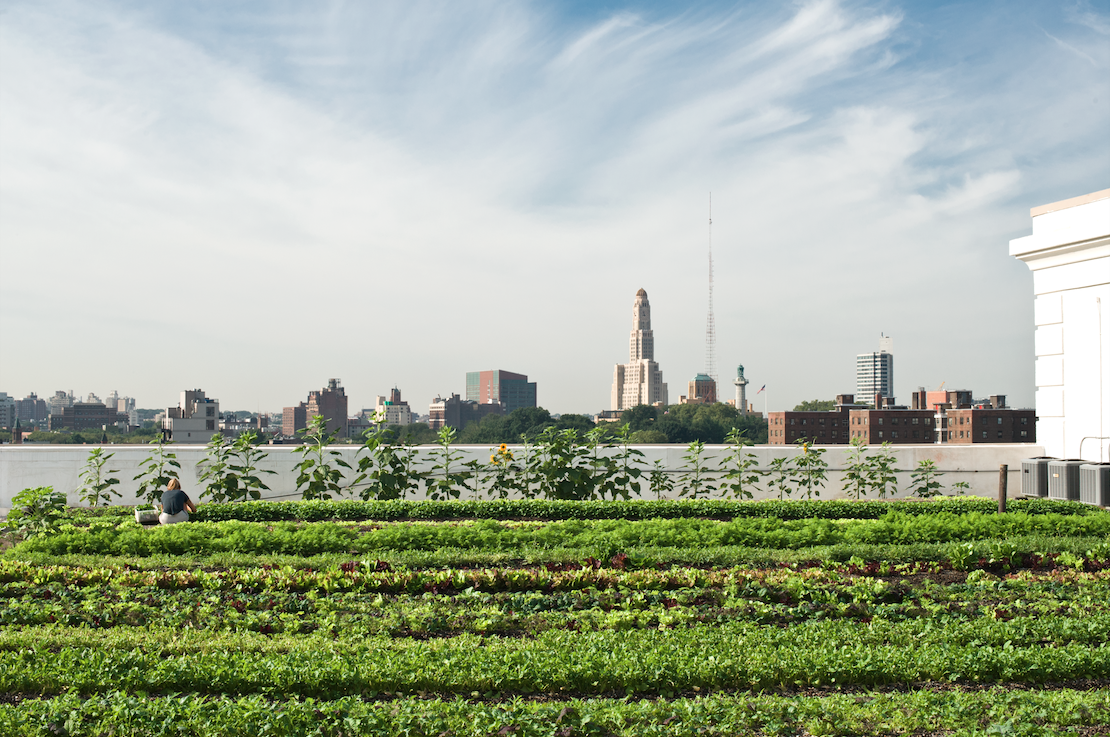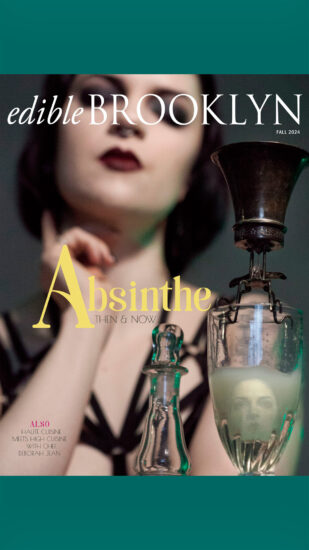
Matt Jefferson was surprised last summer when a refugee-intern from Burkina Faso, whom we’ll call Anna, asked if she might have some overgrown kale and mustard leaves.
They are tough and bitter when they get so big, explains Jefferson, manager for the Brooklyn Grange rooftop farm, and normally go straight to the compost. But in Anna’s homeland, she’d learned to add them to soup, and here they went into her pot with peanuts, rice and dried fish power, a delicious mix of techniques she learned in Africa and ingredients she grows in Brooklyn.
How, you ask, did a refugee end up interning on a Brooklyn rooftop farm? The stage was set in 2010, when Ben Flanner and the Grange’s co-founders built a one-acre farm atop a six-story building in Long Island City, growing greens and other produce to sell to places like Roberta’s and Marlow & Sons. From the start, they were looking for more rooftops to grow on, and two years later, expanded to a second space in the Navy Yard.
“It was perfect,” says Flanner of the acre and a half. While some farmers might look for flat fields or soil fertility, he was excited about easy roof access, a strong building that could bear major rooftop weight, and close proximity to customers like Greene Grape, Northeast Kingdom and the Down to Earth farmers market at Sundays at McGolrick Park. And it got full sun all day.
Flanner, the Grange’s president and head farmer, can tick off rooftop-farm benefits as fast as lettuce varieties, explaining that they shorten the supply chain, reduce carbon footprints, even cool things down during summer’s dog days, when the canopy absorbs solar energy while evaporation lowers the surrounding temperature. Plus the two rooftops’ spongy soils each absorb millions of gallons of storm water per season, such a service that the NYC Department of Environmental Protection awarded the Grange a $592,000 grant.
But he says something impossible to measure is just as important: “When you grow food very close to eaters,” says Flanner, “they have opportunity to come to the farm, to learn, to experience all its trials and tribulations and pleasures.”
Which is precisely why refugees like Anna are here, too.

Maria Blacque-Belair, executive director of the Refugee and Immigrant Fund, lives a few blocks from the Grange’s original Long Island City location and soon became a farm stand regular. She conceived the partnership when she recognized many of the refugees she was working with had agricultural backgrounds and might benefit from agriculture’s healing powers, putting down roots in their new nation.
“And of course I said yes,” laughs Flanner, “because I say yes to most good ideas.”
This season Anna is back at Brooklyn Grange, farming each Wednesday alongside seven other refugees and asylum-seekers as part of the Urban Agriculture Training Program, a partnership between the Grange and RIF, whose goal is to help people escaping persecution, abuse and other traumatizing conditions in their native countries. The new Americans practice their English surrounded by plenty of sunshine, soil and spectacular views of the Manhattan skyline.
Farming at the Grange seemed like a natural way to ease the culture shock of landing in a strange megalopolis — complete with a therapeutic outlet that might make more sense than talking on a couch. “Especially because some of our people — the majority coming from Africa,” explained Blacque-Belair “do not necessarily relate to traditional counseling.”
Anna, for example, had suffered years of abuse in Burkina Faso. But at the farm, surrounded by friends and sharing soup, she said it’s impossible to be depressed. Once afraid to open up, she now gives farm tours to strangers, including the 75 CSA members who come for the weekly pickup each Wednesday.
Beyond a place to practice speaking English while trellising beans and weeding beets, Flanner says the staff offers “a really positive environment, just by being ourselves. A warm and pleasant distraction from a lot of the stresses.”
The partnership has developed to include workshops, job training, resume writing with the Navy Yard Employment Center, even support in obtaining food-safety licenses. Today Jefferson, who had served in the Peace Corps in Africa, volunteers for the RIF on top of his job as farm manager for the Grange, by managing the internship program.
“We’re just here to help people get a good start and soften the landing,” says Flanner.
But he and Jefferson say the refugees aren’t the only ones who benefit. The staff and visitors have formed real connections — and these seasoned farmers have gotten a taste of unique crops, too. One of the participants brought seeds in and the team sowed them together. Sour leaves soon sprouted.
“We don’t know the names of the plants, and did not recognize them visually,” says Flanner, “but she referred to them by the name of the village they came from.”
These new flavors now appear during the daily “family meal” potluck lunch, which might include traditional rice-and-bean dishes, fish preparations, endless incarnations of okra and peppers and those unusual sour leaves. Flanner says the woman who brought their seeds is an enthusiastic cook who also “used leaves from our other crops in ways that we haven’t seen before, cooking down the leaves the leaves of okra, cucumber, and sweet potato into stews. We’ve been cooking amaranth, lambs quarters, dandelions and purslane for years, but this took it to the next level!”

Anna is also passionate about sharing her Burkinabé culture through cooking and a recent Wednesday afternoon found her flipping oblong balls of cornmeal with a bamboo spoon to make fufu, a side dish for her leaf soup, kanzaga, named for the vegetable traditionally used in the recipe back home. Now that she lives and farms here, Anna has been adding all sorts of different leafy greens to her soup including bok choy and amaranth.
She says not wasting even a leaf is a sign of respect for the food, which she learned at a young age.
“The food could be older than you,” Anna said they tell children in Burkina Faso. Now she passes on recipes — and the underlying respect — to others. It is a melting pot of culture where innovative ideas can come from surprising places, like leaves that would have gone to waste.
“We’re learning as much about these people’s cultures,” said Jefferson, “as they are about ours.”
Photo credit: Valery Rizzo



